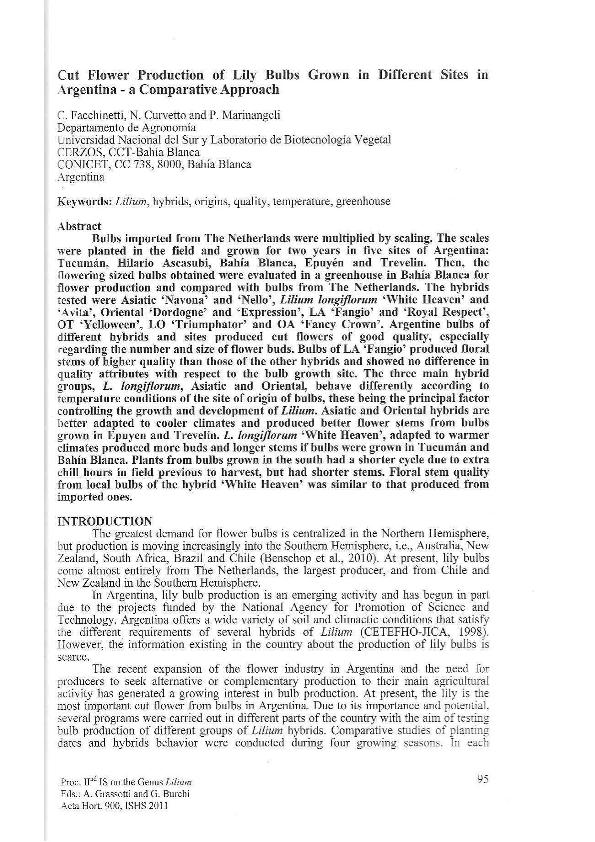Mostrar el registro sencillo del ítem
dc.contributor.author
Facchinetti, Cecilia

dc.contributor.author
Curvetto, Nestor Raul

dc.contributor.author
Marinangeli, Pablo Alejandro

dc.date.available
2017-07-03T14:15:53Z
dc.date.issued
2011-07
dc.identifier.citation
Facchinetti, Cecilia; Curvetto, Nestor Raul; Marinangeli, Pablo Alejandro; Cut Flower Production of Lily Bulbs Grown in Different Sites in Argentina - A Comparative Approach; International Society for Horticultural Science; Acta Horticulturae; 900; 7-2011; 95-104
dc.identifier.isbn
978-90-66052-29-1
dc.identifier.issn
0567-7572
dc.identifier.uri
http://hdl.handle.net/11336/19370
dc.description.abstract
Bulbs imported from The Netherlands were multiplied by scaling. The scales were planted in the field and grown for two years in five sites of Argentina: Tucumán, Hilario Ascasubi, Bahía Blanca, Epuyén and Trevelin. Then, the flowering sized bulbs obtained were evaluated in a greenhouse in Bahía Blanca for flower production and compared with bulbs from The Netherlands. The hybrids tested were Asiatic ‘Navona’ and ‘Nello’, Lilium longiflorum ‘White Heaven’ and ‘Avita’, Oriental ‘Dordogne’ and ‘Expression’, LA ‘Fangio’ and ‘Royal Respect’, OT ‘Yelloween’, LO ‘Triumphator’ and OA ‘Fancy Crown’. Argentine bulbs of different hybrids and sites produced cut flowers of good quality, especially regarding the number and size of flower buds. Bulbs of LA ‘Fangio’ produced floral stems of higher quality than those of the other hybrids and showed no difference in quality attributes with respect to the bulb growth site. The three main hybrid groups, L. longiflorum, Asiatic and Oriental, behave differently according to temperature conditions of the site of origin of bulbs, these being the principal factor controlling the growth and development of Lilium. Asiatic and Oriental hybrids are better adapted to cooler climates and produced better flower stems from bulbs grown in Epuyen and Trevelin. L. longiflorum ‘White Heaven’, adapted to warmer climates produced more buds and longer stems if bulbs were grown in Tucumán and Bahía Blanca. Plants from bulbs grown in the south had a shorter cycle due to extra chill hours in field previous to harvest, but had shorter stems. Floral stem quality from local bulbs of the hybrid ‘White Heaven’ was similar to that produced from imported ones.
dc.format
application/pdf
dc.language.iso
eng
dc.publisher
International Society for Horticultural Science
dc.rights
info:eu-repo/semantics/openAccess
dc.rights.uri
https://creativecommons.org/licenses/by-nc-sa/2.5/ar/
dc.subject
Lilium
dc.subject
Hybrids
dc.subject
Origins
dc.subject
Quality
dc.subject
Temperature
dc.subject
Greenhouse
dc.subject.classification
Agronomía, reproducción y protección de plantas

dc.subject.classification
Agricultura, Silvicultura y Pesca

dc.subject.classification
CIENCIAS AGRÍCOLAS

dc.title
Cut Flower Production of Lily Bulbs Grown in Different Sites in Argentina - A Comparative Approach
dc.type
info:eu-repo/semantics/article
dc.type
info:ar-repo/semantics/artículo
dc.type
info:eu-repo/semantics/publishedVersion
dc.date.updated
2017-05-02T18:58:42Z
dc.identifier.eissn
2406-6168
dc.journal.volume
900
dc.journal.pagination
95-104
dc.journal.pais
Italia

dc.journal.ciudad
Pescia
dc.description.fil
Fil: Facchinetti, Cecilia. Consejo Nacional de Investigaciones Científicas y Técnicas. Centro Científico Tecnológico Conicet - Bahía Blanca. Centro de Recursos Naturales Renovables de la Zona Semiarida. Universidad Nacional del Sur. Centro de Recursos Naturales Renovables de la Zona Semiarida; Argentina
dc.description.fil
Fil: Curvetto, Nestor Raul. Consejo Nacional de Investigaciones Científicas y Técnicas. Centro Científico Tecnológico Conicet - Bahía Blanca. Centro de Recursos Naturales Renovables de la Zona Semiarida. Universidad Nacional del Sur. Centro de Recursos Naturales Renovables de la Zona Semiarida; Argentina
dc.description.fil
Fil: Marinangeli, Pablo Alejandro. Consejo Nacional de Investigaciones Científicas y Técnicas. Centro Científico Tecnológico Conicet - Bahía Blanca. Centro de Recursos Naturales Renovables de la Zona Semiarida. Universidad Nacional del Sur. Centro de Recursos Naturales Renovables de la Zona Semiarida; Argentina
dc.journal.title
Acta Horticulturae

dc.relation.alternativeid
info:eu-repo/semantics/altIdentifier/url/http://www.actahort.org/books/900/900_10.htm
dc.relation.alternativeid
info:eu-repo/semantics/altIdentifier/doi/http://dx.doi.org/10.17660/ActaHortic.2011.900.10
Archivos asociados
